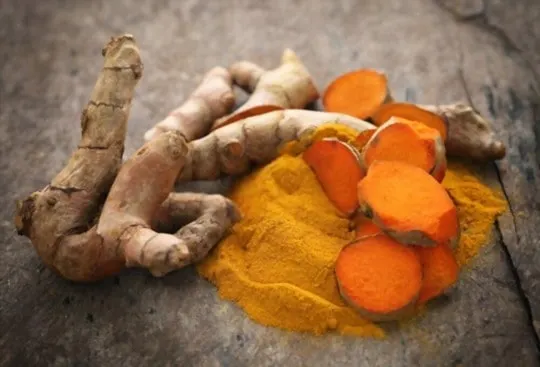Turmeric consists of a flowering plant that comes from the ginger family.
This plant is an herbaceous, perennial, and rhizomatous plant that is native to Southeast Asia and the Indian Subcontinent.
It needs a temperature that ranges from 20⁰-30⁰C as well as a significant amount of rainfall every year to grow and thrive.
The rhizome or root of a turmeric plant is used heavily as traditional medicine and culinary spice.
In India, many people were using it for treating skin disorders, digestive system problems, skin disorders, joint pains, liver disease, and upper respiratory tract issues back in the day.
Curcumin forms a major part of turmeric, and curcuminoids are responsible for turmeric and its activities.
Curcumin is also responsible for giving turmeric its iconic yellow color.
Plus, the majority of the dietary supplements of turmeric come from its dried roots.
You can even recreate tasty turmeric beverage and meal recipes like “Turmeric Tea,” “Delicious Juice Recipe with Turmeric,” “Oven-Baked Turmeric Rice,” or “Turmeric-Pickled Deviled Eggs.
” You can also experiment with it in the kitchen because of the number of possibilities that it has.
Can you freeze turmeric root? Yes. It is absolutely possible for you to freeze your turmeric roots.
You may want to freeze it to extend its shelf-life, especially inside your freezer, where you can store it away for extended periods of time without any problem.
Does Freezing Affect Turmeric Roots?

The answer to that question is a resounding No.
Why? Well, because freezing your turmeric roots will not affect the way it tastes or degrade its quality.
The reason why many folks choose to freeze it is that they want to maintain its freshness for later use in the kitchen.
Yes, the idea of freezing these turmeric roots isn’t the first thing that would come to our minds when we talk about storing fresh veggies, herbs, or spices.
It is, without a doubt, an unpopular approach but very effective at the same time as well.
By storing your turmeric roots inside the freezer, you end up extending their lifespan.
You will be reducing your waste output, too, especially when you have them in large quantities.
But ensure that you clean them properly before popping them inside the freezer.
It will allow them to be clean, fresh, and their flavor will continue to remain intact at all times.
How To Freeze Turmeric Roots?

Here’s how you can freeze your turmeric root with these steps:
Step 1 – Preparing.
The first thing that you need to do is to clean your turmeric roots by using a brush.
You can’t expect to freeze them with dirt and bacteria still intact.
Start scrubbing and rinsing the roots with a brush and water.
Once you clean them, proceed to place them on your cutting board.
Use a paper towel for drying the roots and also getting rid of any remaining debris.
You need to get rid of all the excess moisture.
Step 2 – Cutting.
Now you need to start cutting the roots into small and manageable portions.
To obtain the best results, ensure that you go for 2-Inch pieces.
It will be big enough for one portion and small enough to avoid wasteful leftovers.
Plus, cutting them now will help save time when you have to use them later.
Step 3 – Wrapping.
Now you need to wrap all of the portions together by using a single dry paper towel.
Here, the paper towel starts absorbing any additional moisture on the roots, causing it to last longer in the freezer.
Step 4 – Freezer Bag.
Take the paper towel containing the roots and proceed to put it inside a freezer bag.
Your bag should come with a zip-top.
After you insert everything, start pushing all the air out from your freezer bag.
Start working yourself towards the top and close the zip after you remove as much air as possible.
Step 5 – Labelling.
Lastly, you need to label your freezer bags.
It will help you identify the freezing date and also about what’s in it.
Here, you can use a marker to write directly on the bag.
Step 6 – Freezing.
Now you can proceed to put your turmeric roots inside the freezer.
You can place it inside the main box or at the back of the freezer.
Avoid placing it near the door because turmeric roots thaw quickly.
So, if it comes in contact with the warm room temperature, you will lose its quality and flavor.
Fresh turmeric roots can go for over 3 months inside the freezer.
But if you store, freeze, and handle it carefully, then you can even expect it to go for more than three months.
How To Thaw Frozen Turmeric Roots?

One good thing about turmeric roots is how fast it starts to defrost.
For using your turmeric roots, we would advise you to grate in its frozen state to make it less messy.
If you are planning to make a smoothie, then you don’t have to thaw it.
You can simply add them inside the blender.
If you are cooking a curry dish, then you can simply grate them into the pot without having to defrost it.
Also, if you are making some homemade turmeric tea, you can boil it together with the water.
Thawing isn’t needed here as well.
But if you want to then, you can always let them thaw on your kitchen counter.
It will be useful, especially when you plan to use large batches of the roots.
Caution.
Do not microwave your turmeric roots as a way of thawing them.
We would also advise you to avoid washing it with hot water.
When you take out some of the roots and put back the remaining ones, ensure that you don’t allow any air to get in.
Conclusion
Turmeric roots possess a bitter and warm taste.
Many folks use it for coloring or flavoring their cheeses, curry powders, butter, and mustards.
It is extremely helpful in treating conditions, which involve inflammation and pain.
Its popularity is only increasing with its effective medicinal properties and use in a variety of dishes.
It is quite freezer-friendly, so it won’t give you a hard time as most foods do.
Plus, you can even combine it with black pepper to maximize its benefits.

Can You Freeze Turmeric Roots? A Complete Guide
Ingredients
- Turmeric roots
- Air-tight containers or Ziplock bags
- Labels and markers
Instructions
- Prepare all the mentioned equipment and ingredients in the article.
- Follow the steps for proper freezing.
- Label the container with the date and contents.
- Depending on the recipe, thawing time may vary.
